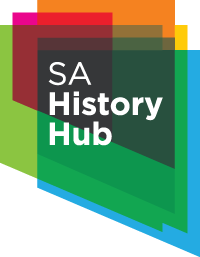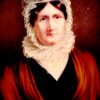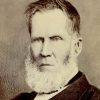John Barton Hack arrived in South Australia via Hobart and Launceston in early 1837. As a Quaker merchant of capital, he and his youngest brother, Stephen, came out on the HMS Isabella with Sir John and Lady Franklin and the newly appointed Chief Judge of South Australia, Sir John Jeffcott. In Van Diemen’s Land, Barton Hack garnered sufficient supplies and livestock to give him a market advantage in the sale of goods and services when he finally arrived in Adelaide. Furthermore, as one of the largest buyers of city acres, 67 in all, and being of good reputation among the Commission’s young executive officers in the colony, he was induced to join the committee of twelve who sat in deliberation over the street names on 23 May 1837.
Unlike some of the other members of that Street Naming Committee, it looks as though John Barton Hack did not push himself forward for consideration, if at all, but instead waited patiently until most of the streets had been named. When the Committee finally came to the outer perimeters of the North Adelaide section, only then did some of the lesser members get a chance to nominate themselves, or in Barton Hack’s case, to suggest members of his own family.
John Barton Hack perhaps more modestly put forward the name of Barton rather than Hack, in deference to the distaff side of his family. He was always called Barton, rather than John and it looks very likely that he named Barton Terrace firstly after his mother, Maria Hack (nee Barton) and then perhaps to a lesser extent after her equally famous brothers, John and Bernard Barton.
Theirs was a well-known Quaker family from Chichester and all three were famous in their own right. John Barton Hack’s mother, Maria, a noted, respected and published author, enjoyed a growing reputation at the time. Her stepbrother, John Barton Jnr, had become a distinguished political economist. Bernard Barton, Maria’s younger and adoring brother, was a poet and confidant of Charles Lamb. It is difficult to avoid the conclusion that John Barton Hack was acutely aware of his mother’s family and its achievements, but it was most likely his mother to whom he wished to give the greatest acclaim. At a time when women were still in many ways persona non grata, there was no better way to bring her forward than in the streets of Adelaide. Barton Terrace is therefore, rather surprisingly, the only original street in Adelaide which is named after a woman.
Maria Hack (nee Barton) was born of Quaker parents on 26 February 1777 and died in January 1844. She was a much-loved writer of children’s books in the late-eighteenth and early part of the nineteenth centuries, during which time her writings were viewed as full of moral instruction clothed within a series of educational disciplines; hence her contemporary reputation as a curriculum writer.
John the elder, her father (1755–1789), was a prominent Quaker who had come from Carlisle in Cumberland, Cumbria. He was one of a twelve-strong anti-slavery advocacy group called the Society for Effecting the Abolition of the Slave Trade, which convened in London, in 1787. Nine members of the group were Quakers.
Maria’s mother, Mary Done (b. 1752) died in 1784, not long after the family moved south to London and probably because of complications from the birth of Maria’s younger brother Bernard. Maria was then only 7 years old. When her father remarried Elizabeth Horne of Bankside in Tottenham, Maria drew her younger brother unto herself in such a way that he later pays great tribute to her for being his mentor and oracle, especially during his childhood. Maria and Bernard’s stepbrother, John Barton Jnr, came from their father’s second marriage. When John Barton the elder died in 1789, he left Maria to be raised by her stepmother, Elizabeth. It must be said that Elizabeth had a profound influence on all three children. Each had an exemplary education and they all gained prominence in society through their respective good works and publications.
Maria defied the odds in a patriarchal society. She became a household name, with her charming books for juveniles which did so much to introduce children to the classics and to a sense of moral propriety. In all respects her writings reflect a highly refined sense of English and world history, a good grounding in science as it was then understood, and a full appreciation of the Greek and Roman classics, including a facility for both language and grammar. This is not surprising because her contemporaries in the Quaker community in and around Tottenham included Elizabeth Fry, Priscilla Gurney and Priscilla Wakefield who all frequently visited one another, sharing mutual interests in education, the eradication of poverty, the abolition of slavery and prison reform. Maria married Stephen Hack on 17 November 1803. She was 23 and he a young Quaker merchant who was importing Irish provisions and corn.
At the point of their marriage, Stephen inherited the Hack Currier and Leather Cutting business, so the family was placed in a comparatively strong financial position. Amazingly, they had ten children and Maria still found time to run a large household and sneak some time to write. In these trying circumstances she was prolific. Many of her books went into second and third editions.
The mid-1820s and 1830s were a time of intellectual foment in this extended Quaker community. Maria earned a name for herself as a more than competent debater.
After the death of Maria’s husband Stephen in 1823 there is some evidence that the intellectual and devotional parameters of her life began to change. She drifted away from the central tenet of Quakerism where guidance from God is given by an ‘inner light’, adopting instead a more fundamentalist position based on the revelation of the gospel. This position required a commitment to both baptism and communion, and by 1837 she heeded the call from the Manchester-based Quaker dissident Isaac Crewdson and was baptised. She finally broke with the Quakers entirely before joining the Anglican Church. Her stepbrother John, who had converted to Anglicanism in 1827, and some of her children also left the Quakers, but Bernard couldn’t help but be disappointed with both his sister and his stepbrother.
With her sons John Barton and Stephen Hack falling on hard times in Australia (in 1843) and her daughter, Margaret Emily, successfully married into the Thomas Gates Darton Publishing House, Maria Hack died at Bevis Hill in Southampton on 4 January 1844.
While the discussion about Barton Terrace necessarily centres on Maria Hack and to a lesser extent her son John Barton Hack, some biographical detail about her two brothers is warranted. This is important for two reasons. Firstly, it helps explain the profound significance of the Barton name among the Quakers of Chichester. Secondly, a little detail about the two brothers helps to understand the degree of influence Maria had over them during their childhood. Given their achievements in later life, this was palpable.
John Barton was probably more famous than Bernard at the time. With the advantage of wealth, particularly after he married Ann Woodrouffe Smith in 1811, and having flirted briefly with business activities as a partner in the Hack Currier and Leather Cutting business, he was able to put this aside for more philanthropic and intellectual pursuits. There followed his appointment as Secretary of the Lancastrian School Society (1810), Secretary to the Chichester branch of the British and Foreign Bible Society (1816) and patron and financier of the National Church of England School at Westbourne (1819). He was a fervent promoter and Treasurer of the Chichester Mechanics’ Institute (1825) and founder of the Chichester Savings Bank. As with his sister, education of the young was a high priority for him.
John Barton Jnr was, however, first and foremost a political economist; an exponent of the new and powerful intellectual movement which married the politics of nationhood with the growth of national wealth. In a career which has seen him described as a political economist, a statistician and an amateur botanist, his two most significant ideas were in economics. The first concerns the Malthusian dictum that population will always outrun subsistence. McCulloch, taking some of his argument from Barton, concluded that the death rate in a community is always more important than the birth and marriage rates. John Barton’s other smaller but significant contribution to economic theory stems from a discussion on the short-term effects of the introduction of machinery into the production process.
Bernard Barton, Maria’s blood brother, who is described as a minor poet of the time, was well known not only to Charles Lamb, but also to Robert Southey, Barron Field and other notable writers of the day. Since John’s mother died not long after he was born, he attributes most, if not all of his literary sensitivity to his sister, Maria. In 1824 John Gurney raised Bernard’s public profile through a benefit which realised £1,200. As a muse he obviously delighted the rich and powerful, for after Sir Robert Peel left office he procured a pension of £100 a year for Bernard.
John Barton Hack, Maria’s son who was on the Street Naming Committee, was born in 1805 and died in 1884. He was named after the Barton line of the family, which originally hailed from Ivegill in Cumberland. Of a similar age to most of the young radicals who were junior appointees in the colony, he mixed freely with them on his arrival in Adelaide. Like most of them he was an inaugural member of the South Australian Club. As his father Stephen had made a success of banking in Chichester, John and his youngest brother (also Stephen) were engaged in the family currier and leather business, which they eventually sold to fund their exploits in South Australia.
On 9 July 1827 John Barton Hack married Bridget Watson, and by 1836 they had six children under 8 years of age when he decided to emigrate. It is known that he had met with Robert Gouger and Wakefield at the South Australian Commission office at the Adelphi. He also knew John Morphett and Captain Lipson before emigrating.
John Barton Hack arrived in Van Diemen’s Land on 1 January 1837. Some of the stock he was carrying on the Isabella was lost overboard. This was to be typical of the fate Hack suffered financially on several more occasions, before he finally went bankrupt in the early 1840s.
On first arrival, however, he was greeted with great enthusiasm as he landed his working bullocks on the beach at Glenelg. He immediately began contracting to transport goods from the beach at Holdfast Bay and from the swampy landing at the ‘old Port Adelaide’, and within days he was raking in a handsome profit. Hack’s first house in the colony lay close to his store in Hindley Street, somewhere near where the first Adelaide Railway Station was later built on North Terrace. He was doing well for himself, and besides purchasing another 65 acres at the time of the land auction in early 1837 he was the proud owner of one of the few weatherboard homes in the colony.
His subsequent exploits in Adelaide were many and varied. Unfortunately, by the early 1840s as the colony slumped into a recession because of a lack of rural production, John Barton Hack was forced into a bankruptcy from which he never really fully recovered.
Between then and his death, John Barton Hack never quite reached the heady days of the late 1830s. A sojourn as a ‘bullocky’ carting copper from the mines at Burra to the coast at Port Wakefield; time as the manager of the North Kapunda Mine; a timber merchant and builder in North Adelaide; a quest with four of his sons to the goldfields in Victoria; and time as an accountant to one of Adelaide’s leading lawyers almost filled his days. He did retain a highly respected position in the community. He was variously a member of Adelaide’s first Grand Jury, Chairman of the Chamber of Commerce, Vice President of the Agricultural Society, Auditor to the Literary and Scientific Association and the Mechanics’ Institute and a director of the Adelaide Auction Company.
His last days were spent as Controller of Railway Accounts in the fledgling public service of the Government of South Australia. He died on 4 October 1884 and is buried in the Cheltenham Cemetery, on Port Road.






Comments